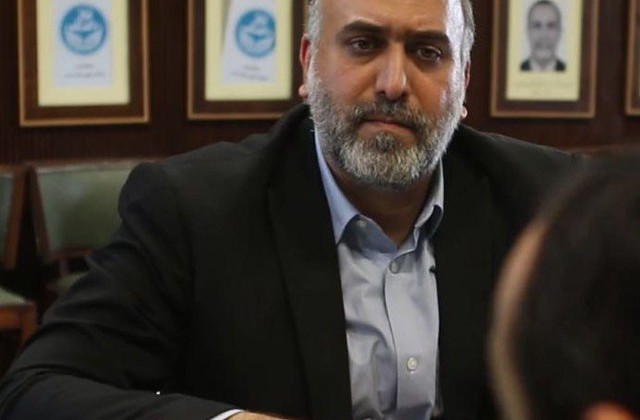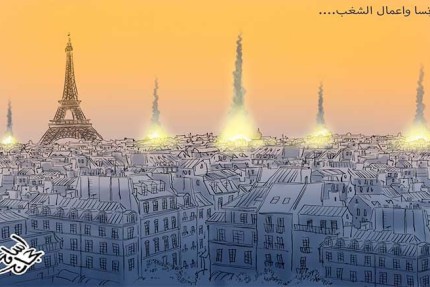Dr. Mohammad Ali Senobari
Director of the New Vision Center for Strategic Studies

A Majestic Scene: How the Funeral of Martyrs Nasrallah and Safi al-Din Revealed Hezbollah’s Strategic Depth?
The funeral of Hezbollah’s martyrs, Sayyed Hassan Nasrallah and Sayyed Hashem Safi al-Din, was not merely a ceremony bidding farewell to great leaders; rather, it was a resounding declaration of strength, unity, and resilience. This event sent shockwaves among both supporters and opponents alike. Those who viewed the funeral as a mere emotional event to boost Hezbollah’s morale failed to grasp the deeper significance of this historic moment. It was not just about mourning; it was a message of defiance, strength, and unwavering commitment to resistance.
The mass mobilization accompanying the funeral was not a reaction to tragedy but rather a declaration of continuity and defiance. It served as evidence of Hezbollah’s resilience, not only as a military force but as a deeply rooted social and political entity. When analyzing this event, it becomes clear that Hezbollah’s strength is not merely derived from its leadership, weapons, or battlefield victories, but from the organic relationship it has built with its people, its ability to adapt to shifting geopolitical realities, and its strategy and vision that extend beyond Lebanon’s borders.
Beyond Mourning: A Testament to Endurance and Control
Traditionally, a funeral signifies closure. It represents an end, a farewell, a moment of sorrow and reflection. However, the funeral of Hezbollah’s leaders took place in an entirely different context. It was not about an ending but rather a reaffirmation of continuity and evolution.
The massive crowds that flooded the streets were not just a display of loyalty but living proof of Hezbollah’s deep entrenchment in Lebanese society. Contrary to what many observers expected, the funeral was not a moment of weakness but one of consolidation. It demonstrated that Hezbollah’s strength does not flow from its leaders to its base; rather, it emerges organically from the base itself. The people do not follow Hezbollah passively; they are its foundation and the source of its power.
Many political movements throughout history have faced existential crises after the assassination or loss of their key leaders. Their ranks have crumbled, their ideologies wavered, and their followers dissipated. Hezbollah’s adversaries had anticipated a similar trajectory, expecting the martyrdom of Sayyed Hassan Nasrallah to push the party into disarray. Instead, the funeral proved that Hezbollah’s fundamental strength does not lie solely in individuals but in a well-structured institutional system of governance, military organization, and mass mobilization.
The funeral was carried out with meticulous precision, without any breakdown in control despite the immense size of the crowd, which in itself was a powerful message. It debunked the notion that Hezbollah’s authority over its base relies solely on its leadership. This event was not a fleeting occurrence; rather, it was an affirmation that the party’s grip on its supporters remains firm, even under the most emotionally charged circumstances.
A Mass Mobilization That Redefined Perceptions of Power
One of the most striking aspects of this event was the sheer scale of participation. The funeral was not limited to Hezbollah’s direct base; it became a national and even international phenomenon. Participants arrived from more than 80 countries, making it one of the most significant mobilizations in modern Arab history.
This level of participation shattered many narratives that Hezbollah’s adversaries had long sought to cultivate. First, it dispelled the notion that Hezbollah is an isolated entity, a sectarian force confined to Lebanon’s Shiite community. The presence of people from different sects, nationalities, and backgrounds demonstrated that Hezbollah’s influence extends far beyond its traditional constituency. It is not merely a Lebanese or regional player but a global symbol of resistance.
Second, the funeral undermined the persistent Western narrative that Hezbollah is losing its grip on popular support. In reality, such a vast and sustained turnout would have been impossible if Hezbollah’s base were eroding. Instead, the event showcased a level of popular commitment that few political organizations—whether in Lebanon or across the region—could ever dream of achieving.
This public display also carried another significant implication: Hezbollah’s adversaries are not merely contending with a military force or a political faction, but with a deeply entrenched socio-political entity backed by the loyalty of hundreds of thousands, if not millions, of people. No amount of military pressure, economic sanctions, or political isolation can simply dissolve a movement that enjoys such widespread legitimacy among its supporters.
What the Funeral Revealed About Hezbollah’s Organizational Strength
The funeral was also a testament to Hezbollah’s organizational discipline—a characteristic that has long set it apart from other armed and political movements in the region.
Despite the intense emotional atmosphere, the event remained under strict control. Hundreds of thousands of people moved in an organized manner, there were no security breaches, and not a single gunshot was fired—an almost unprecedented feat for a gathering of this magnitude in the Arab world. This was not merely an example of crowd control; it was a reflection of Hezbollah’s military, political, and social discipline.
This level of organization sends a direct message to Hezbollah’s adversaries: its internal cohesion remains intact. The Zionist entity, along with its Western backers, has long sought to weaken Hezbollah from within, hoping to foster internal divisions and sow discord. The funeral proved that these efforts have failed. Hezbollah remains a well-oiled machine, capable of managing not only its fighters on the battlefield but also its vast network of supporters in times of crisis.
Moreover, this discipline speaks to Hezbollah’s military capabilities. If it can organize an event of this magnitude with such precision, then it undoubtedly possesses the logistical and strategic capacities needed to sustain prolonged military engagements. This realization is crucial in understanding why Hezbollah remains an indomitable force despite continuous attacks from the occupying entity.
A Strategic Victory in the Face of Assassination
Following the assassination of Sayyed Hassan Nasrallah, there was a widespread belief—especially among Hezbollah’s enemies—that this marked the beginning of the party’s downfall. Some Western analysts prematurely concluded that Hezbollah had suffered an irreversible blow, one that would dismantle its leadership structure and plunge its operations into chaos.
However, the post-assassination phase and its aftermath proved the exact opposite. Rather than disintegrating, Hezbollah quickly reorganized, maintaining its political and military operations seamlessly. Within days, it restored its internal communication networks, adjusted its battlefield strategy, and continued its resistance efforts without interruption.
The fact that the occupying entity ultimately agreed to a ceasefire following these events is itself an admission of failure. Had Hezbollah truly been on the verge of collapse, as some speculated, the Zionist entity would have pressed forward to deliver a decisive blow. Instead, the enemy realized that Hezbollah remained intact—it was still capable of launching counterattacks, still commanding its forces, and still operating with strategic precision.
This ability to swiftly recover from setbacks is a hallmark of Hezbollah’s long-term resilience strategy. Unlike conventional state armies, which rely on hierarchical command structures that can be crippled by the loss of a leader, Hezbollah operates within a highly coordinated yet decentralized framework.
The party is designed to withstand the loss of individual figures because its strength lies in its ideological foundation, institutional framework, and deeply ingrained strategic adaptability.
Reshaping the Political Equation in Lebanon
Beyond its immediate military and strategic implications, the funeral also had a significant impact on Lebanon’s internal political landscape. Hezbollah has long played a dual role—as a resistance movement against Zionist aggression and as a key political actor within the Lebanese state.
Following this event, Hezbollah subtly but decisively shifted the responsibility of addressing the five occupied points in southern Lebanon to the Lebanese government. By allowing the state to take the lead in dealing with external mediators and handling the issue of occupation, Hezbollah reinforces the notion that it does not operate outside the Lebanese political framework but within it.
This move achieves two primary objectives. First, it forces the Lebanese state to acknowledge that the “people, army, and resistance” equation is the only viable framework for safeguarding national sovereignty. Second, it signals to the international community that Hezbollah is not a rogue actor but a legitimate national force operating within Lebanon’s broader political structure.
The funeral of Hezbollah’s martyrs was not a moment of weakness but a testament to the movement’s resilience, discipline, and strategic depth. It demonstrated that Hezbollah remains firmly in control, that its base is as committed as ever, and that its adversaries have fundamentally miscalculated its staying power.
Far from marking the beginning of the end, this occasion signaled the start of a new chapter in the resistance—one in which Hezbollah, despite all efforts to weaken it, continues to evolve, adapt, and assert itself as an unyielding force in the struggle for liberation.
Comment
- October 7th Regained the Arab and Muslims’ Honor and Dignity
- Hamas Reaction to Trump’s Plan is Logical and Results from National Duty
- Hashd Shaabi : The Same Ideology and Approach as of Martyr Nasrallah
- Lebanon Resistance Will Renew its Forces Against Occupation
- Palestine is recognized as a sovereign state by the UK, Canada and Australia
- Some Key Points on Snapback Trigger
- Epstein’s case postponed after the killing of Charlie Kirk
- Netanyahu intends to turn Gaza into a wasteland
- Some Key Points on Israel Attack Against Qatar: From Negotiations Under Fire to the Trap of “Negotiations and War
- A Statement from the journalists from the Arab and the world over in supporting the Dutch ministers
- “Dark Days are Awaiting the Zionists.”
- Iran’s Sources of Power Without Relying on Weapons of Mass Destruction
- October 7th Regained the Arab and Muslims’ Honor and Dignity
- Hamas Reaction to Trump’s Plan is Logical and Results from National Duty
- Hashd Shaabi : The Same Ideology and Approach as of Martyr Nasrallah
- Lebanon Resistance Will Renew its Forces Against Occupation
- Palestine is recognized as a sovereign state by the UK, Canada and Australia
- Some Key Points on Snapback Trigger
- Epstein’s case postponed after the killing of Charlie Kirk
- Netanyahu intends to turn Gaza into a wasteland
- Some Key Points on Israel Attack Against Qatar: From Negotiations Under Fire to the Trap of “Negotiations and War




